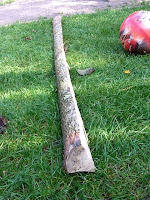In the last few days I tested my bows and made some changes. The first hazel bow didn't have an arrow rest cut into the handle. When I first shot the bow it felt really good. It's really satisfying to shoot your own handmade bow. Unfortunately it wasn't really accurate, the arrows didin't fly in a straigth line to the target. I was hesitating a bit to cut an arrowrest in the finished bow, worried about weakening the handle and breaking it.
But after a few more shots this was the best option, so I first drew the shape of the arrow rest on the handle and used my jigsaw and rasps to get the desired shape.
On my other maple bow the handle/grip was not really comfortable, so I wanted to make a leather grip. My neighbour had a leather jacket that he wanted to get rid of so I was really happy to help him out :)
First I made a paper template and traced this on the leather. After it was cut I wanted to decorate it with a pattern. For some other projects, like my Maori powerkite, I use a Pfaff 1221 sewing machine. It's a powerfull German machine, that works through 3 layers of leather without any problem.
The sewing machine has a lot of different patterns built in, for normal sewing, but also for decoration purposes.
Here's some image of the variety of stitches:


The final wrapped handle looks like this:
Tomorrow I will work on a leather arm guard in the same style, so please check back soon!

























